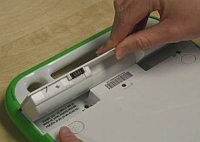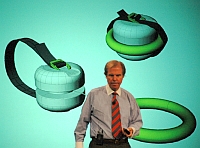What if you had a laptop computer that lasted for six hours running at the highest consumption mode where you are watching video, playing games, or listening to music while you surfed the Internet, and formed a Internet node for your friends?
What if, when that same computer was idle, just providing the mesh network connectivity, its battery life was measured in days? That's the amazing power-sipping profile of the OLPC XO detailed by Michail Bletsas, Chief Connectivity Officer, One Laptop per Child, as recorded by James Turner in his "Notes From a Senior Editor: A Close Look at the OLPC" article for Linux Today.
[T]he power profile of the unit changes dramatically depending on what the child is doing. Peak consumption is around 5 watts for high-demand media applications, it falls to around 3 watts for browsing, under a watt when used as an e-Reader in black and white mode, and only 350 milliwatts to participate in the mesh network.How's that for literally clock-stopping hot technology? Hot Nickel Metal Hydride battery technology that is designed to burn at a cool (and safer) 106 degrees C. Battery technology that will also be good for 15,000 cycles, up from the usual 500! Such is the questionable additional claim James Turner attributes to Michail Bletsas.
While the operational electricity draw and battery life claims are in agreement with previous OLPC talks, and stunning all by themselves, the 15,000 cycles goes way beyond what Mark J. Foster says the Children's Machine XO will be capable of:
We want to deliver 2000 battery cycles. Now I don't know if any of you upgrade your machines too often, but the reality is for most people, a battery lasts about a year and a half if you're a reasonably heavy user of it. About 500 cycles, that's about it. Battery capacity starts to go way down, forget it, go get another battery. […]Wild cycle claims aside, Michail Bletsas does report that the 23-watt Nickel-Metal Hydride battery can be fully charged in 2.5 hours using Potenco's string power generator, the OLPC Yo-Yo.So what we're doing is we're working with a battery manufacturer to make a new version of Nickel Metal Hydride. Modified chemistry that our target is to actually deliver 2000 usable real battery cycles.
If we can still believe Mr. Turner's report of Mr. Bletsas, the OLPC Yo-Yo will generate around 10 watts. So for 10 minutes of pulling, the Children's Machine XO could run for 30 minutes doing 3 watts of non-intensive computing. Or you could always use the OLPC Yo-Yo for other tasks. As Colin Bulthaup of Potenco says:
One minute of pulling gives 1 hour of light, 25 minutes of talk time on the phone, 230 minutes of iPod shuffle use, 45 minutes on the Nintendo DS.And at a projected $10 commercial price, I intend on yo-yoing a few more electronics myself!




"So for 10 minutes of pulling, the Children's Machine XO could run for 30 minutes doing 3 watts of non-intensive computing."
That's not so hot. From what I recall, the goal was ten minutes of computing for every one minute of human-powered electricity generation.
Eduardo,
Jim Gettys mentions in his Linux.conf.au presentation that OLPC found the 10-1 ratio out a little too ambitious and Nicholas Negroponte now admits that the hand-crank is fantasy but defends it's initial inclusion as a quick way to get the human power idea across.
If the values that are supplied for the Potenco device are correct and the Laptop does draw around 1 watt in e-book mode then 1 minute of charging should equal 10 minutes of reading.
We all know that battery powered devices should never be used like this as the best battery life is gained by full charge/discharge cycles.
You really need to quantify what the term 'computing' really means in the world of the OLPC Laptop. Different usage modes draw different amounts of power. Color mode with backlighting on and calculation intensive processes are all going to peak the power usage.